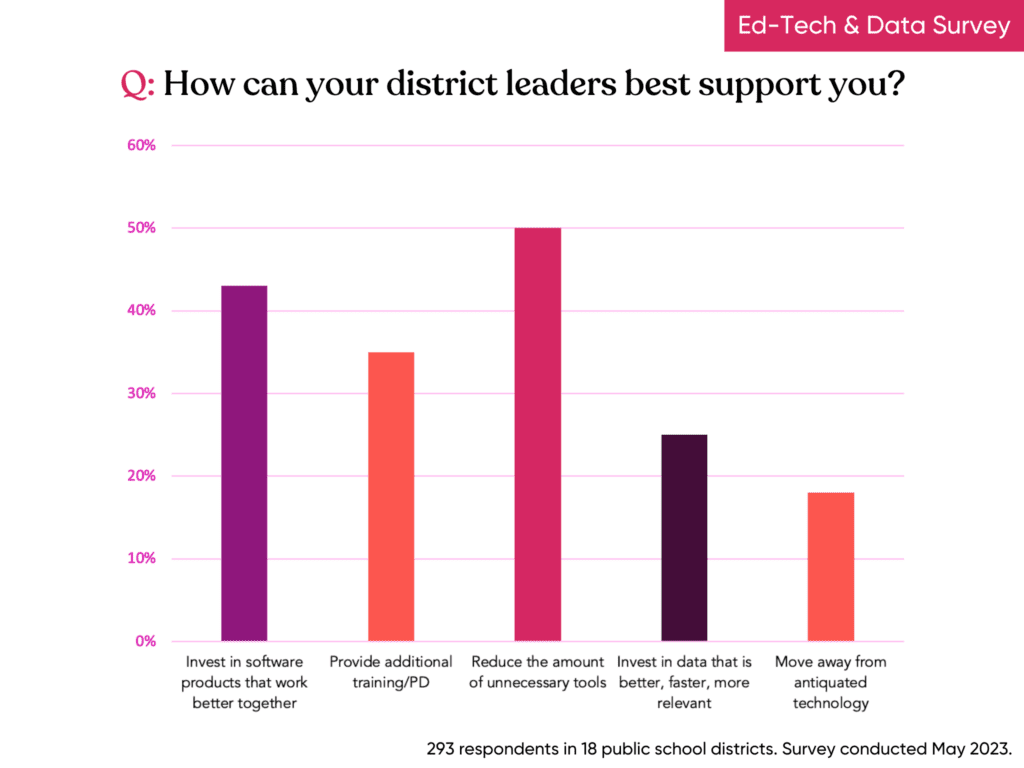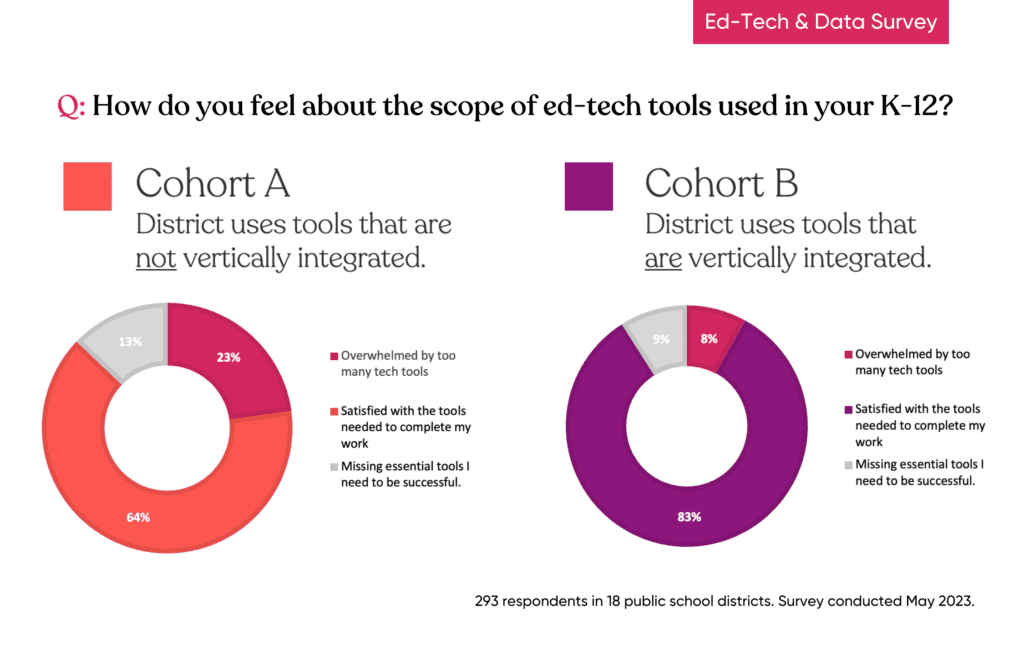Hello, you are using an old browser that's unsafe and no longer supported. Please consider updating your browser to a newer version, or downloading a modern browser.
Hello, you are using an old browser that's unsafe and no longer supported. Please consider updating your browser to a newer version, or downloading a modern browser.

300 educators weigh in on the obstacles keeping them from being successful with tech and data.
Research shows that schools with consistent data-guided practices experience an increase in student achievement that is equivalent to an additional month of schooling.*
But there’s a catch. Most schools can’t quite get data practices to sustain.
Despite two decades of professional development on the topic of data-driven decision making, there are persistent barriers that keep schools from realizing the growth potential that data promises.
When asked why data and technology isn’t working for them, educators tend to point to the same one or two obstacles.
In May 2023, 300 educators across eighteen K-12 school districts were asked to reflect on the data and technology they used every day. The first response was revealing.

This result makes it clear that quality of data is not the issue. Rather, nearly 60% of respondents felt that their technology tools were not adequately integrated.
This lack of integration has only gotten more dire after the explosive proliferation of digital tools to support distance learning.
Despite interoperability frameworks like LTI making the classroom experience more cohesive, many instructional leaders continue to struggle with an unmanageable amount of disparate data streams.
This issue of disconnected data sources is known as “fragmentation,” which plagues not only school districts, but many types of organizations and corporations, according to a recent McKinsey study.
“The technology infrastructure at most…companies is complex and fragmented. Organizations use a mix of modern and legacy systems, and their critical data are distributed across those systems. Those data can be hard to access, difficult to interpret, and of inconsistent quality.”
This data fragmentation was a major source of frustration among educators polled.

50% of respondents wished their leaders would cut down on unnecessary tools. That result is sharply at odds with the most common approach that school leaders take to solve their data woes.
School leaders tend toward additive steps to address data, like buying data warehouses or building complex Google Sheets, which only serve to exacerbate the underlying problem of time-wasting data silos.
These piled-on data tools tend to fall rapidly into disuse. This is also indicative of a lack of meaningful integration with other day-to-day processes. There is an urgent need for a radically different approach to solving fragmentation, one that prioritizes integration, efficiency, and instructional relevancy.
One promising remedy is called “vertical integration.”
Schools with an overwhelming amount of tools and data streams tend to share one common characteristic: they have not yet adopted “vertical integration” as a criteria for ed-tech acquisitions.
Vertical integration is the degree to which a district’s education technology products can natively share data and functionality inside a single connected platform. It’s important to know what is NOT considered vertical integration:
These tactics can reduce time wasted in the gap between systems, but most tech departments have already taken these steps. Their educators still attest to deep dissatisfaction with integration, as evidenced in the survey results above.
A pursuit of true vertical integration requires districts to undertake a comprehensive reimagining of a district’s entire ed-tech portfolio. District leaders that have successfully pursued vertical integration have surprising results:
Schools without vertical integration see nearly 1 in 4 educators report being overwhelmed by technology. Comparatively, only 1 in 10 educators in vertically integrated schools felt overwhelmed.
Respondents attribute the significant improvement to:
Where would your school begin with vertical integration? It must start in a specific place: the district’s Student Information System.
Trying to build a vertically integrated school district without considering the SIS is like constructing a house without building a foundation. The district’s Student Information System must be the focus of vertical integration because:
Some modern SIS providers have recognized the value of vertical integration and have expanded their products to integrate more academic support tools.
Here’s one example from the OnCourse Student Information System. This platform offers vertically integrated data visualization, data warehousing, assessment, and intervention tools, as well as traditional SIS functions like grades, transcripts, and state reporting.
Having this data-rich feature set vertically integrated into the OnCourse SIS makes disparate data warehousing obsolete. It eliminates the “one more login” problem and puts data in the same system that staff use to complete their day-to-day tasks.
This raises engagement with data using inventive features like the OnCourse Student Story, which brings together 25+ aspects of a student’s academic, social, extracurricular, and behavioral career into one screen.
To learn more about the OnCourse Student Information System, read more here or watch this 15-minute demonstration.
Features like the OnCourse Student Story can provide a more three-dimensional picture of a student’s career to support districts’ whole child initiatives:
“Research recognizes that…reliance only on test scores and indicators of student performance is inadequate.
Educators need data, such as demographics, attendance, health, transportation, motivation, home circumstances (i.e., homelessness, foster care, potential abuse, poverty), and special designations (i.e., disability, language learners, bullying) to contextualize student performance and behavior.
This type of holistic approach may never be possible until a district makes a real commitment to vertical integration.
*Assessing the Effects of a School-Wide Data-Based Decision-Making Intervention on Student Achievement Growth in Primary Schools. Marieke van Geel, Trynke Keuning, Adrie J. Visscher, Jean-Paul Fox
American Educational Research Journal, Vol. 53, No. 2 (April 2016), pp. 360-394 (35 pages)

We use cookies to analyze our traffic. We share anonymized and aggregated data about the use of our website with analytics partners. Please see Privacy Policy for more information.